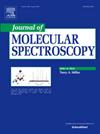Two codes for calculation of the rotation-spin-tunneling energy levels in the microwave and the infrared spectra of O2 (Σg-3)-XY2 open-shell complexes
IF 1.3
4区 物理与天体物理
Q4 PHYSICS, ATOMIC, MOLECULAR & CHEMICAL
引用次数: 0
Abstract
We developed new FORTRAN codes that employ two different Hamiltonians [Wafaa M. Fawzy, J. Mol. Spectrosc., 397, 111,822, 2023] for calculation of energy levels and relative intensities of rotational transitions in an asymmetric or a symmetric top weakly-bonded open-shell dimer. The type of complexes of interest consist of a polyatomic/diatomic closed-shell molecule and the O2 diradical in its ground electronic state, where the monomers experience rotation-tunneling motion. The programs set up the Hamiltonian matrix considering pure rotation, quartic and sextic centrifugal distortion terms, electron-spin electron-spin coupling, R-dependence of electron-spin constants, electron-spin-rotation interaction, a symmetry treatment for rotation-tunneling of the monomers, and dependence of the rotational constants on the rotation-tunneling state. Numerical diagonalization of the total Hamiltonian matrix in the molecular basis set provides the eigenvalues and the eigenfunctions. The eigenfunctions are used to transform expectation values of the parity, five quantum numbers (<P>, <K>, <N>, <Ps>, <Σ>), and the electric dipole moment matrix elements from the Hamiltonian basis set to the eigenfunctions basis of the complex. Calculations showed that goodness of the quantum numbers depends on geometry and relative values of the electron–spin electron–spin coupling constants, the rotational parameters, the tunneling splitting. We used the Hellman–Feynman theory for calculation of derivatives of the eigenvalues with respect to molecular parameters, which significantly reduces the computer time for the non-linear least squares fits of transitions. The FORTRAN suites of computer programs were tested and validated by fitting the high resolution IR and MW spectra of the O2–DF and the O2-SO2 dimers, respectively, with standard deviations within accuracy of the frequency measurement. However, the codes should be suitable for spectral analysis of any O2 -XY2 or O2 -XY cluster, where XY2 and XY represent a closed-shell non-linear triatomic molecule of C2v symmetry (e.g. H2O) and a diatomic entity (e.g. CO), respectively. The FORTRAN source programs, input and output files for spectral fits of the MW spectrum of O2-SO2 are discussed. In addition, zipped files of the suites of programs, the input and output files for fitting the MW spectrum of O2-SO2 and the IR spectrum of O2 -DF, respectively, are provided as supplements that can be downloaded.

O2 (Σg-3)-XY2开壳配合物的微波和红外光谱中旋转-自旋隧穿能级的两个计算程序
我们开发了新的FORTRAN代码,使用两种不同的哈密顿量[Wafaa M. Fawzy, J. Mol. Spectrosc]。计算非对称或对称顶部弱键开壳二聚体的能级和旋转跃迁的相对强度[j],[397, 111,822, 2023]。这种类型的配合物由一个多原子/双原子闭壳分子和处于基电子态的O2双自由基组成,其中单体经历了旋转隧道运动。程序建立了考虑纯旋转、四次和六次离心畸变项、电子-自旋耦合、电子-自旋常数的r依赖性、电子-自旋-自旋相互作用、单体旋转隧穿的对称处理以及旋转常数对旋转隧穿态的依赖性的哈密顿矩阵。对分子基集中的总哈密顿矩阵进行数值对角化,得到了特征值和特征函数。本征函数用于将宇称、五个量子数(<P>, <K>, <N>, <Ps>, <;Σ>)和电偶极矩矩阵元素的期望值从哈密顿基集合转换为复合体的本征函数基。计算表明,量子数的优劣取决于几何形状和电子-自旋耦合常数、旋转参数、隧穿分裂的相对值。我们使用Hellman-Feynman理论计算特征值相对于分子参数的导数,这大大减少了非线性最小二乘拟合过渡的计算机时间。通过拟合O2-DF和O2-SO2二聚体的高分辨率IR和MW光谱,在频率测量精度的标准偏差范围内,对FORTRAN计算机程序套件进行了测试和验证。然而,这些代码应该适用于任何O2 -XY2或O2 -XY簇的光谱分析,其中XY2和XY分别代表C2v对称的闭壳非线性三原子分子(例如H2O)和双原子实体(例如CO)。讨论了用于O2-SO2的MW谱拟合的FORTRAN源程序、输入和输出文件。此外,还提供了程序套件的压缩文件、O2- so2的MW谱拟合输入文件和O2 -DF的IR谱拟合输出文件作为补充,可供下载。
本文章由计算机程序翻译,如有差异,请以英文原文为准。
求助全文
约1分钟内获得全文
求助全文
来源期刊
CiteScore
2.70
自引率
21.40%
发文量
94
审稿时长
29 days
期刊介绍:
The Journal of Molecular Spectroscopy presents experimental and theoretical articles on all subjects relevant to molecular spectroscopy and its modern applications. An international medium for the publication of some of the most significant research in the field, the Journal of Molecular Spectroscopy is an invaluable resource for astrophysicists, chemists, physicists, engineers, and others involved in molecular spectroscopy research and practice.

 求助内容:
求助内容: 应助结果提醒方式:
应助结果提醒方式:


